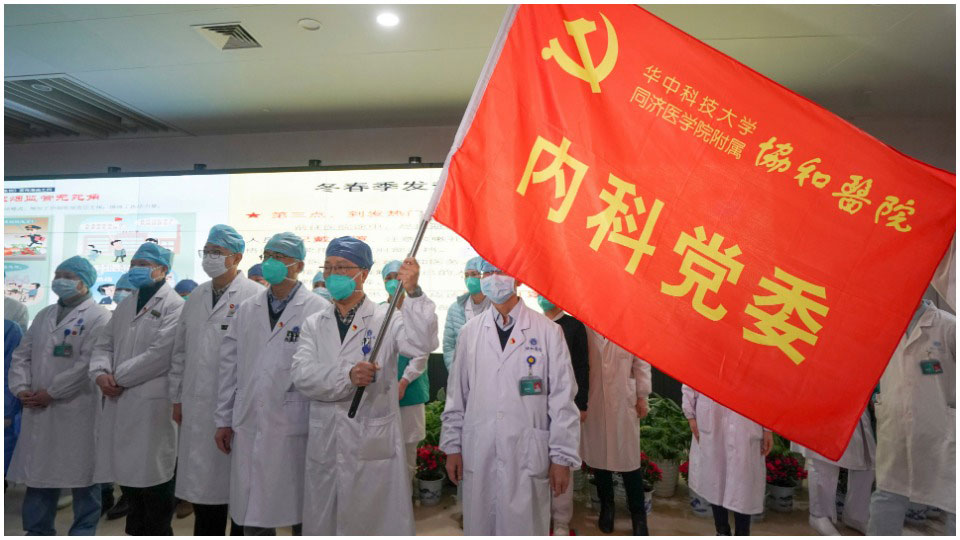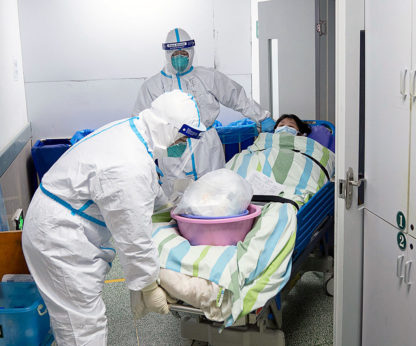
SINGAPORE—The usually celebratory atmosphere of Lunar New Year was markedly more subdued across Asia this weekend as government officials in China fought to contain the outbreak of a deadly new coronavirus that has, as of this writing, infected nearly 2,700 and taken the lives of more than 80. Unprecedented efforts are being made to halt the spread of the pneumonia-like respiratory illness caused by the coronavirus, which is believed to have originated in a seafood market where illegal wildlife meat was sold.
Three more cases in the U.S. were confirmed Sunday, two in California and one in Arizona, according to information released by the Centers for Disease Control and Prevention. Two earlier cases were confirmed in Chicago and Washington state. The CDC said it is monitoring just over 100 patients in 26 states for possible infection.
Throughout most of China, mass gatherings to welcome the Year of the Rat were canceled Friday and Saturday, while other countries allowed events to go forward but encouraged greater vigilance among the public. Lunar New Year is the world’s biggest annual human migration, with hundreds of millions traveling to be with family—both within China and around the globe. But the rapid spread of the coronavirus put a damper on this year’s big move, leaving many—especially migrant workers in some of China’s major cities—unable to get back to their hometowns.
The city of Wuhan, in Hubei province, is the epicenter of the outbreak and has effectively been sealed off. All planes, trains, and other links were cut as of last Wednesday. Public transport and private vehicle travel within the urban core are now suspended, with some 6,000 taxis coordinated by the government to provide the city’s neighborhoods with essential transportation.
Officials there say they took the measure to “ensure the safety and health of the people.” Similar but less intense regulations are now in effect in other cities surrounding Wuhan, bringing the total number of people quarantined to 50 million.
The World Health Organization is praising the Chinese government’s quick response to the crisis, with director-general Tedo Adhanom Ghebreyesus saying the country was taking “very strong measures…with full commitment.”
Rapid response
The scale of that commitment is now ramping up in a massive way—showcasing the ability of the country’s socialist state to marshal resources rapidly and efficiently in the service of public health.

The government of Wuhan has launched a rush campaign to construct special hospitals to treat coronavirus patients and provide relief for the city’s overwhelmed health care system. The first 1,000-bed hospital is already being built, with completion expected for Feb. 3—a total construction time of just six days.
Video broadcast on Friday showed dozens of excavators and bulldozers leveling the site where the hospital will rise. Construction workers are demonstrating their own devotion to the project, with many giving up their holidays to return to work. Engineer Wu Zhizhen told the Associated Press he was driven by a sense of responsibility, taking only five hours’ break per day. “As a Wuhan resident and construction staff, I have an obligation to contribute all I can,” he said. “We have to get things done ahead of schedule.”
On Jan. 25, the first day of Lunar New Year, People’s Daily—newspaper of the governing Communist Party of China—announced a second new facility would also be built, adding another 1,300 beds. It is planned to open within two weeks.
The two facilities will provide treatment catered specifically to the needs of those who’ve contracted this new illness and act to contain its spread. They are modeled on a similar prefabricated hospital built in Beijing in 2003 to deal with the SARS crisis. That health center was completed in seven days; the first Wuhan coronavirus hospital will come online a day faster.
Besides the quarantine efforts in Hubei province and the express hospital construction, a number of new measures are now being pursued to contain the outbreak. The Chinese Center for Disease Control and Prevention says it is working to develop a vaccine to protect people from contracting the illness.
The head of the National Institute for Viral Disease Control at the center, Xu Wenbo, said on Sunday that research was underway to identify and isolate the seed strain and determine the most effective drugs to treat the pneumonia caused by the virus.
Additionally, 450 medical staff from the People’s Liberation Army are now on the way to Wuhan to provide relief to doctors and nurses there. Among the military medics being sent are many who gained experience during the SARS and Ebola outbreaks.
People before profit
The top leadership of the Communist Party met in Beijing on Saturday to strategize on the next steps for combatting the illness. The meeting decided that the party’s Central Committee would establish a special commission devoted to controlling the outbreak.
Party General Secretary Xi Jinping, who is also president of China, chaired the meeting. “Life is of paramount importance,” he said. “When an epidemic breaks out, a command is issued. It is our responsibility to prevent and control it.” He said that party members at all levels and across the country must “stand on the frontline” to safeguard public health.

An editorial in People’s Daily similarly encouraged a united national effort to battle the coronavirus’ spread. It said that everyone has to participate and be willing to sacrifice when necessary, but also said government officials must do everything they can to minimize the impact of containment efforts on citizens’ daily lives.
The paper called the crisis “a test for China’s governance system and capability,” saying it was especially urgent to guarantee the storage and supply of drugs and medical supplies. “China, as the world’s factory, does not lack a production force, and filling the current supply gaps is not a difficult matter. We call on the relevant parties to put the pedal to the floor to guarantee production, and urge every city in the country to offer mutual assistance to get through the challenge.”
On Wall Street, meanwhile, profit rather than public health was the focus. In New York, the stocks of airlines, travel companies, casinos, and tourism-oriented companies were down in Friday trading as investors worried about how the China travel freeze could impact margins.
This downward pressure was balanced, however, by eager financial advisers telling their clients to buy shares in companies that manufacture masks and medical supplies and biotech firms that make vaccines—especially as the United States reported its first case of the coronavirus.
Market analyst Elizabeth Balboa Benzinga provided readers of Yahoo! Finance with a list of “13 Coronavirus-Related Stocks to Watch.” Writing about Lakeland Industries, which makes protective biohazard gear for health workers, Benzinga reminded investors that the company “has historically surged during outbreaks and proved a favored supplier amid the Ebola outbreak.”
Profiteering from the crisis was banned in China, though, as the country’s market regulators threatened “speedy and severe punishment” for any businesses caught price-gouging or hoarding medical supplies. A hotline has been set up for the public to report violators.
The contrasting responses of government and Communist Party officials in China and that of Wall Street investors puts the distinction between the socialist and capitalist systems in sharp relief and prompts the question: Which comes first—people or profits?
Note: The numbers of infected and killed listed at the beginning of the article were updated shortly after publication to reflect new information provided by Chinese authorities and the U.S. Centers for Disease Control and Prevention.

MOST POPULAR TODAY


Zionist organizations leading campaign to stop ceasefire resolutions in D.C. area

High Court essentially bans demonstrations, freedom of assembly in Deep South

Afghanistan’s socialist years: The promising future killed off by U.S. imperialism

Communist Karol Cariola elected president of Chile’s legislature






Comments